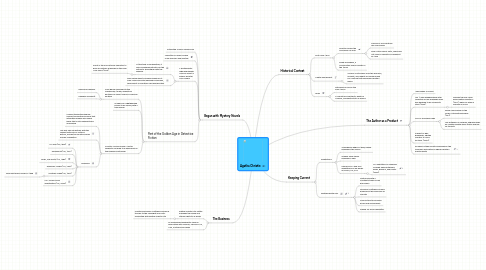
1. Began with Mystery Novels
1.1. Estimated 4 billion copies sold
1.2. Vignettes of Upper Middle Class manners and lifestyle
1.3. 2 protagonists: dignified Belgian Hercule Poirot & elderly spinster Miss Marple
1.3.1. At the time of composition, it was considered patriotic for the British to sympathize with the Begians
1.3.1.1. Poirot is the only fictional character to have an obituary published in the New York Times (1975)
1.3.2. Miss Marple dwelt in English village of St. Mary Mead and often appeared confused, reminiscent of Christie's own grandmother
1.4. Part of the Golden Age in Detective Fiction
1.4.1. Cosy genre compared to the "hardboiled," tough, insensitive portrayal of violent crime in American mystery
1.4.1.1. Raymond Chandler
1.4.1.2. Dashielle Hammett
1.4.2. Murders as a lighthearded puzzle to be solved, with a tidy ending
1.4.3. Country-House Murder: a set of suspects confined to a large house in the English countryside
1.4.3.1. Cluedo utilized this popular suspect-elimination process that interested readers as a board game that is still manufactured and played
1.4.3.2. Her play The Mousetrap, with the longest initial run of a play in history, follows the country-house murder convention
1.4.3.3. Television
1.4.3.3.1. Dr. Who (UK, 1963)
1.4.3.3.2. Whodunnit! (UK, 1972)
1.4.3.3.3. Mrder, She Wrote (US, 1984)
1.4.3.3.4. Diagnosis Murder (US, 1993)
1.4.3.3.5. Jonathan Creek (UK, 1997)
1.4.3.3.6. CSI: Crime Scene Investigation (US, 2000)
2. The Business
2.1. Agatha Christie Ltd. estate manages the media and literary rights to all works
2.1.1. Christie's grandson Matthew Prichard is the heir to the copyright and is still associated with Agatha Christie Ltd.
2.2. All licensing arrangements made in association with Chorion, offices in UK, USA, Australia and Japan
3. The Author as a Product
3.1. "The Queen of Crime"
3.2. Her 11 day disappearance after revelation of her husbands affair was believed to be a publicity stunt (1926)
3.2.1. Inspired the play "Who Killed Agatha Christie?" (1974), which re-aired in Swindon in 2002
3.3. Icon of an English Lady
3.3.1. Dame Commander of the Order of the British Empire (1971)
3.3.2. Her birthplace in Torquay, England holds an "Agatha Chistie Walk" that is popular for tourists
3.4. Subject of BBC Biography, Agatha Christie: A Life in Pictures (2004)
3.5. Academic study recently published in the Guardian speculates on aging Christie's mental health
4. Keeping Current
4.1. Adaptations
4.1.1. Videogames begin in 1988, rapidly released in the 2000s
4.1.2. Graphic novel series released in India
4.1.3. Numerous TV and Film adaptations of her books in France, UK, USA
4.1.3.1. iTV adaptation of Sparkling Cyanide adds footballers wives, glamour, and nudity (2003)
4.2. AgathaChristie.com
4.2.1. Chatrooms with a constant stream of fan discussion
4.2.2. Grandson Matthew Prichard blogs about his memories of Christie
4.2.3. Online store to purchase books and memorabilia
4.2.4. Signup for email newsletter
5. Historical Context
5.1. First novel: 1920
5.1.1. Directly follows the conclusion of WWI
5.1.1.1. Decline of old industries like coal mining
5.1.1.2. Rise of the Labour Party, which did not reach a majority in Parliament by 1945
5.1.2. Ruled by Baldwin, a conservative Prime Minister in the 1920s.
5.2. Capital Punishment
5.2.1. A public controversy over the specifics, morality, and legality of murder made for a culture that devoured Christie's genre.
5.3. WW2
5.3.1. Rationing of food in the early 1940s
5.3.2. A climate of incertainty, death of civilians, and destruction of homes
